Authentic German Rouladen
This post may contain affiliate links. See my disclosure policy.
One of Germany’s most famous and delicious dishes, Rouladen (Rinderrouladen) are beef roulades filled with bacon, onions, mustard and pickles, then browned and simmered in the richest gravy imaginable. Mouthwateringly delicious and made the way my Mutti and Oma made it, this authentic Rouladen recipe is the only one you’ll ever need!
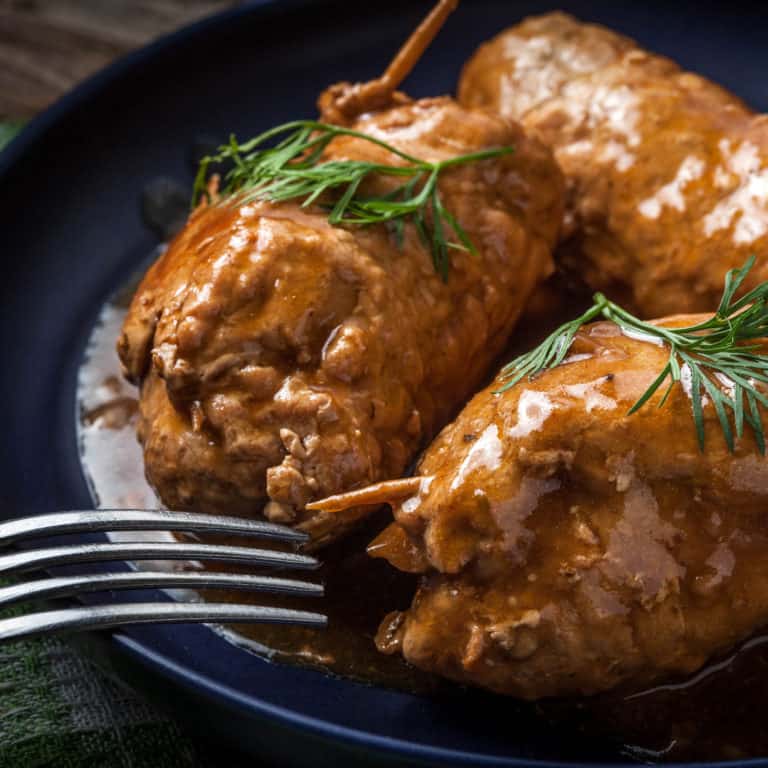
The BEST Rouladen Recipe
Growing up in Stuttgart, we regularly enjoyed family dinners with my Oma and Opa. My Oma was famous for her Kasseler, Kartoffelpuffer, Sauerbraten and her Rinderrouladen (beef roulades). When a meal included gravy she always knew to make extra when we came over because I would heap copious amounts of it over my meat, potatoes, Semmelknödel, Kartoffelklöße, Rotkohl, Sauerkraut, you name it. (I still do.) For me the gravy was one of the primary highlights of the meal. Rouladen is one of my all-time favorite German dishes and its accompanying gravy is arguably the king of all gravies. Today I’m sharing my homemade Rouladen recipe with you and I’m confident you’re going to love it as much as we do!
What is Rouladen?
Rouladen is a traditional German dish featuring long, thin strips of meat slathered with mustard and filled with bacon, onions, and pickles. The filling is enclosed by rolling up the meat strips and the roulades are then browned and slow-simmered in a rich gravy.
Beef rouladen are enjoyed throughout the year in Germany but are often associated with Sunday dinners and special occasions like Christmas Eve.
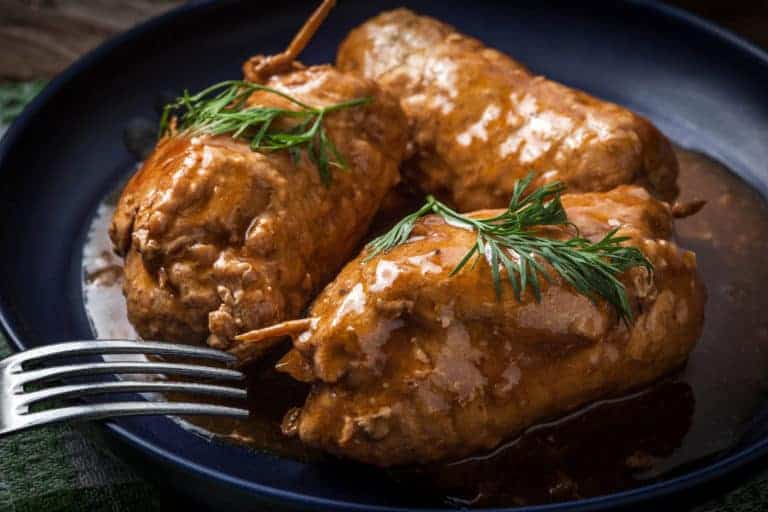
Rouladen Recipe
Rouladen aren’t hard to make, but they do take time. You can shave off some time on the day of your meal by assembling the rouladen ahead of time and chilling them until you’re ready to cook them.
Rouladen are made by spreading some German mustard on thinly cut slices of beef, adding bacon, sliced German pickles and chopped onions. Sprinkle with some salt and pepper and roll them up, securing the rolls with toothpicks or cooking twine. Next you generously fry the rouladen in oil until they’re nicely browned on all sides. They’re then removed and set aside so you can saute the onions and vegetables for the gravy. Add the liquids and spices to the cooked veggies and nestle the rouladen in this mixture to simmer on low until the meat is fork tender. The rouladen are removed, the sauce is poured through a strainer, and the resulting gravy is returned to the pot and thickened. The rouladen are returned to the gravy, heated through and served with Rotkohl and boiled potatoes, Knödel, or Spätzle.
Below I’ve provided step-by-step pictured instructions to ensure your success!

Prepare the slices of beef. They need to be large enough to stuff and roll up, at least 4×6 inches in size and about 1/4 inch thick. This recipe makes 2 rouladen per person. Alternatively you can make larger rouladen and serve one large rouladen per person.
Lay the beef slices out on a work surface. Spread each beef slices with about 2 teaspoons of German mustard and sprinkle with a little salt and freshly ground black pepper.
Place a strip of bacon on each beef slice so it’s running the same length as the beef. Place the sliced German pickles and chopped onions on each beef slice.
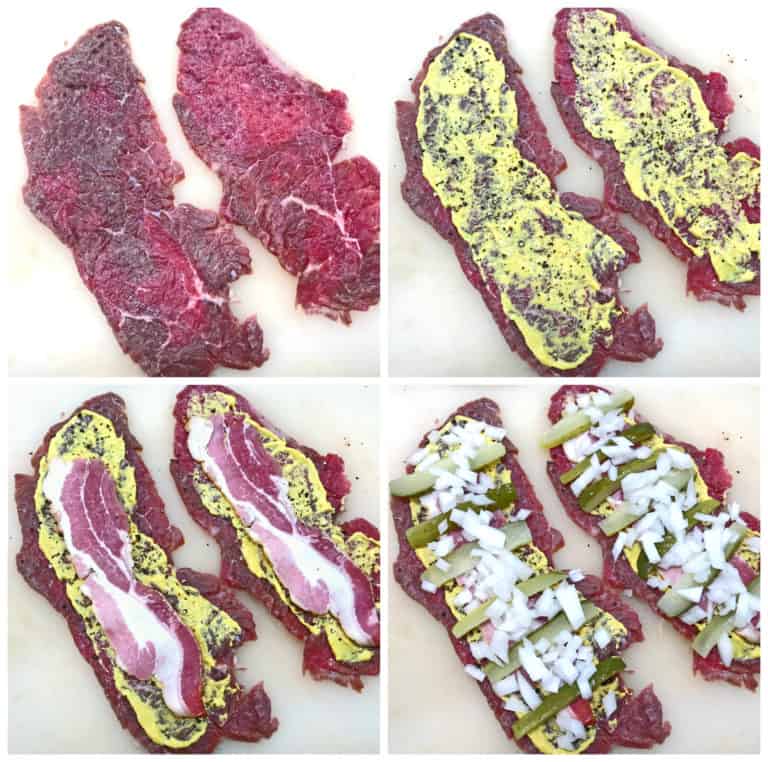
Roll up the beef slices, tucking in the sides as best you can and securing the beef rolls with toothpicks or cooking twine.

Heat the butter and oil in a heavy Dutch oven or pot (make sure it’s oven-safe if baking in the oven) and generously brown the rouladen on all sides. Browning them well will ensure a rich and flavorful gravy. Set the rouladen aside on a plate.
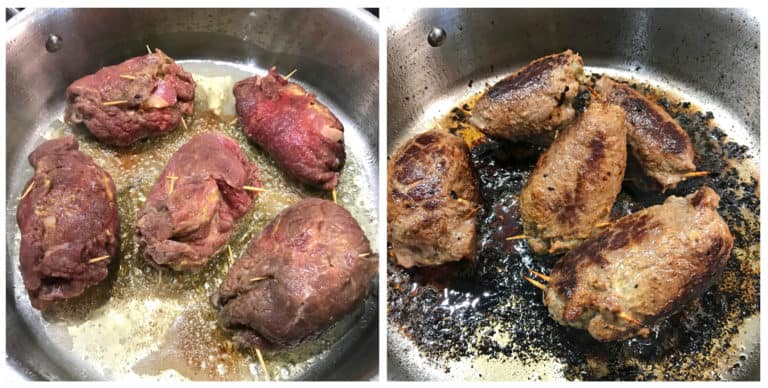
*Do not remove the browned bits in the bottom of the pan, it’s key to the most flavorful gravy!
Add the onions to the pot and a little more butter or oil if needed. Cook the onions until softened and translucent, about 5 minutes. Add the garlic and cook for another minute. Add the leek, carrots and celery and cook for another 5 minutes. Pour in the red wine, bring to a rapid boil for one minute, reduce the heat to medium and simmer for 2-3 more minutes.
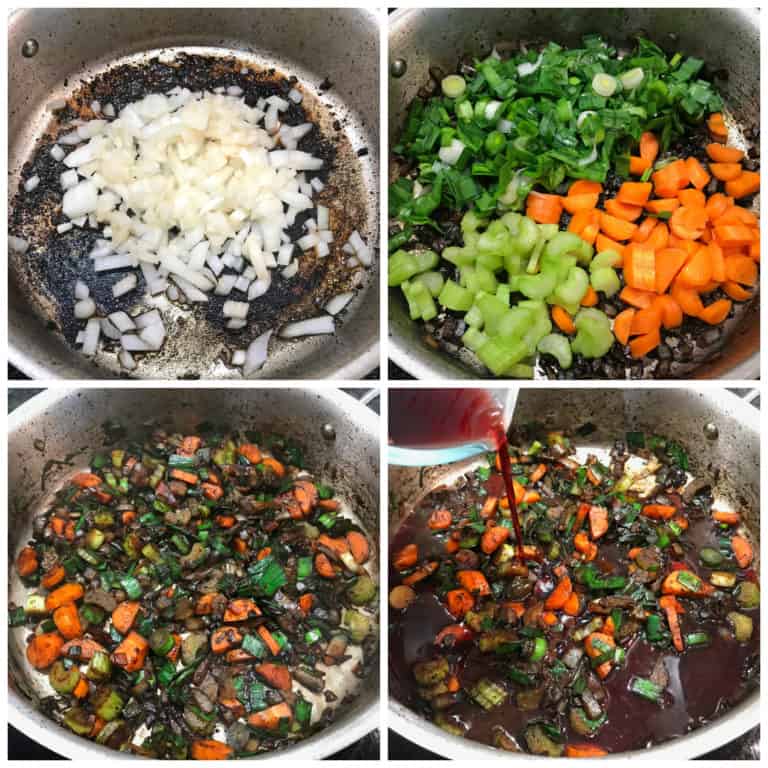
Add the beef broth, tomato paste, bay leaf, salt and pepper. Nestle the rouladen in the pot.
Oven or Stovetop: You can cook the rouladen, covered, on the stovetop on low for about 90 minutes or until fork tender but for the most even cooking we recommend transferring the pot (make sure it’s oven-safe) to the oven preheated to 325 F and cook it there for about 90 minutes or until fork tender.
To Make the Rouladen Gravy:
When the beef is fork tender, remove the rouladen from the pot and set aside. Pour the liquid and vegetables through a strainer and reserve the liquid. (You can set the veggies aside for another purpose, they are yummy. Or you can puree the veggies in the blender and then return them to the gravy.)

Return the strained liquid back to the pot and bring to a simmer. Thicken the gravy either with either a cornstarch slurry (for a clear/translucent gravy) or flour slurry (for an opaque gravy). For a creamy gravy you can also add a few tablespoons of heavy cream at this point. Simmer, whisking constantly, until the gravy is thickened.
Add the chilled butter, whisking constantly, until the butter is melted and incorporated. Add salt, pepper and mustard to taste. Note: If you’d like creamy gravy you can stir in some heavy cream at this point.
Carefully remove the toothpicks or cooking twine from the rouladen and return them to the gravy and heat through.
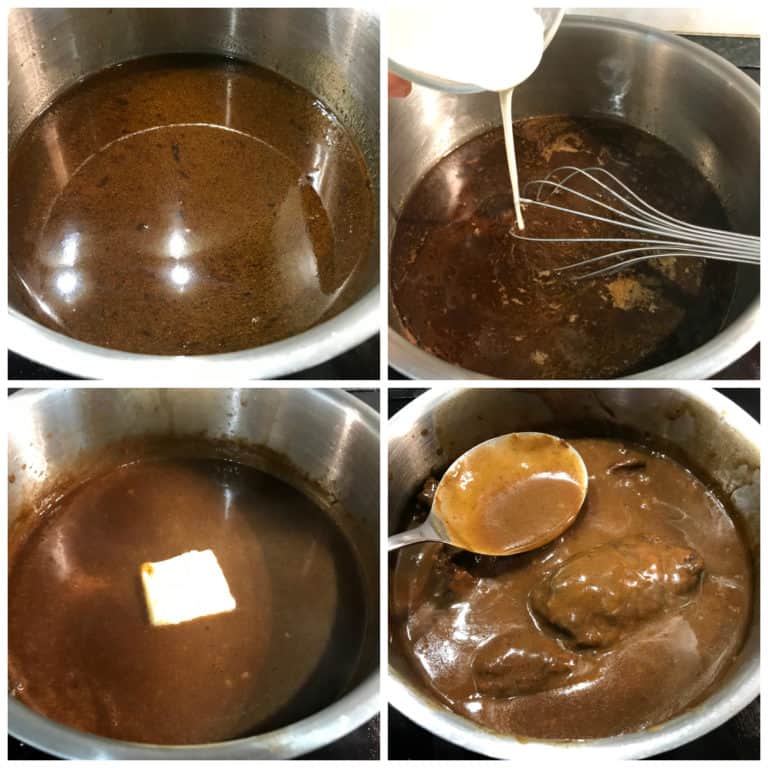
Can Rouladen Be Made Ahead Of Time?
You can save time by assembling the rouladen in advance and chilling them until you’re ready to cook them. They are also good reheated.
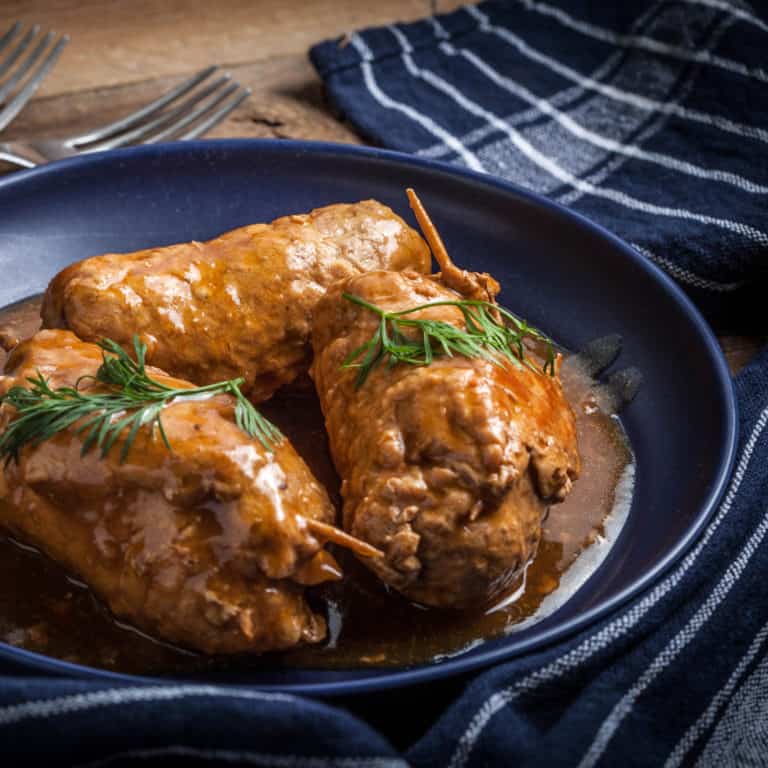
What to Serve With Rouladen
You can pair your Rouladen with any number and variety of sides much like you would a beef roast. Here are some traditional German sides you can pair with your Rinderrouladen:
- Rotkohl (German Red Cabbage)
- Spätzle (German Noodles)
- Semmelknödel (German Bread Dumplings)
- Kartoffelklöße (German Potato Dumplings)
- Kartoffelpuffer (German Potato Pancakes)
- German Potato Salad (Kartoffelsalat)
- Creamy German Cucumber Salad (Gurkensalat)
- Bohnensalat (German Green Bean Salad)
- German Carrot Salad (Karottensalat)

For more authentic German dishes try my:
- Sauerbraten
- Königsberger Klopse
- Käsespätzle
- German Potato Salad
- Senfbraten
- Schnitzel
- Jägerschnitzel
- Schweinshaxe
- Maultaschen
- German Potato Soup
- Frikadellen
Save This Recipe
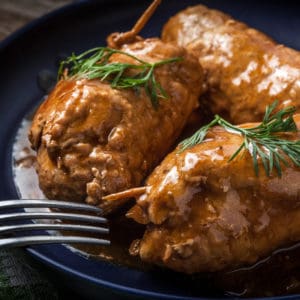
Authentic German Rouladen
Equipment
Ingredients
- For the Rouladen:
- 8 slices top round beef, about 4×6 inches in size and 1/4 inch thick (*see note) (ask your butcher), gently pound the slices with a meat mallet until they're a little thinner than 1/4 inch (be careful not to pound holes into them)
- 1/3 cup German yellow mustard
- 8 slices bacon
- 8 medium German pickles , sliced lengthwise
- 1 medium yellow onion , chopped
- salt and freshly ground black pepper
- For the Gravy:
- 1 tablespoon butter
- 1 tablespoon cooking oil (I use avocado oil because it's ideal for high heat)
- 1 medium yellow onion , chopped
- 1 clove garlic , minced
- 1 small leek , chopped, rinsed and drained in colander
- 1 large carrot , chopped
- 1 large celery stalk , chopped
- 1 cup dry red wine
- 2 cups strong beef broth
- 1 tablespoon tomato paste
- 1 bay leaf
- 1 teaspoon sugar
- 1/2 teaspoon salt
- 1/4 teaspoon freshly ground black pepper
- 4 tablespoons chilled butter
- cornstarch or flour dissolved in a little water for thickening (depending on how much gravy liquid there is you'll need about 1-2 tablespoons of cornstarch dissolved in 2-3 tablespoons of water or 2-3 tablespoons flour dissolved in 1/4 – 1/3 cup water)
Instructions
- Lay the beef slices out on a work surface. Spread each beef slices with about 2 teaspoons of mustard and sprinkle with a little salt and freshly ground black pepper. Place a strip of bacon on each beef slice so it's running the same length as the beef. Place the sliced German pickles and chopped onions on each beef slice. Roll up the beef slices, tucking in the sides as best you can and securing the beef rolls with toothpicks or cooking twine.
- Heat the butter and oil in a heavy Dutch oven or pot (make sure it's oven-safe if baking in the oven) and generously brown the rouladen on all sides. Browning them well will ensure a rich and flavorful gravy. Set the rouladen aside on a plate.
- *Do not remove the browned bits in the bottom of the pan (important for a flavorful gravy): Add the onions to the pot and a little more butter or oil if needed. Cook the onions until softened and translucent, about 5 minutes. Add the garlic and cook for another minute. Add the leek, carrots and celery and cook for another 5 minutes. Pour in the red wine, bring to a rapid boil for one minute, reduce the heat to medium and simmer for 2-3 more minutes. Add the beef broth, tomato paste, bay leaf, sugar, salt and pepper.
- Nestle the beef rouladen in the pot. Oven or Stovetop: You can cook the rouladen, covered, on the stovetop on low for about 90 minutes or until fork tender, but for the most even cooking we recommend transferring the pot (make sure it's oven-safe) to the oven preheated to 325 F and cook it there for about 90 minutes or until fork tender.
- To Make the Rouladen Gravy:When the beef is fork tender, remove the rouladen from the pot and set aside. Pour the liquid and vegetables through a strainer and reserve the liquid. (You can eat the veggies on the side or puree them in the blender and then return them to the gravy.) Return the strained liquid back to the pot and bring to a simmer. Thicken the gravy either with either a cornstarch slurry (for a clear/translucent gravy) or flour slurry (for an opaque gravy). For a creamy gravy you can also add a few tablespoons of heavy cream at this point. Simmer, whisking constantly, until the gravy is thickened.Add the chilled butter, whisking constantly, until the butter is melted and incorporated. Add salt, pepper and mustard to taste. Note: If you prefer a creamy gravy you can stir in some heavy cream.Carefully remove the toothpicks or cooking twine from the rouladen and return them to the gravy and heat through.
- Serve the rouladen and gravy with Homemade Rotkohl and either Homemade Spätzle, Homemade SemmelKnödel (or Kartoffelknödel) or boiled potatoes.
Notes
- This recipe makes 2 rouladen per person. Alternatively you can make larger rouladen for one large rouladen per person.
Nutrition
Originally published on The Daring Gourmet October 29, 2019



















I made this, the spatle, the sauerbraten and the red cabbage for a group of friends for an authentic German meal. Everyone loved it. I didn’t change a thing in the recipe. The only down part is that there were SO many ingredients to buy, and it was quite pricey. I even bought the authentic German items you linked to (pickles, mustard, and sauerkraut). Will make again. The Rouladen and the cabbage were the most loved by the group.
Thank you, Sonja, I’m so glad everyone enjoyed it! Yes, Rouladen are pricey and definitely not an everyday type of meal. They’re also time-consuming to make (but oh so worth it!) and growing up we had them on special occasions.
I’m 75 y.o. Both of my parents were born & raised in Germany, and Rouladen and Sauerbraten were both meals that were saved for special occasions- usually around the Christmas holidays. I have Mom’s very old German cookbook, but even though I took German in H.S., I cannot read it. Those recipes are the BEST, and I thank you for having them in writing, since Mom never wrote them down… just showed how to make them. I helps to get really good beef, from a butcher who knows how to cut for Rouladen, and I still pound it really well. We leave out the pickle as everyone in my family is pretty much a big fan without it. Served with spaetzle & rotkohl. I can make spaetzle, but when I asked Mom for the red cabbage recipe, she told me, “I got modern. They make good stuff that comes in a jar.” (lol). Thank you for your written recipes. Great reference when my memory is not what it used to be. My family LOVES it, and always look forward to it, and it gets raves from folks not familiar with it. Thank you for all your really authentic German recipes!!
Thank you, Georgette! I make Rotkohl from scratch when I have the time but I agree with your mom – the stuff in the jars really IS very good and definitely convenient! :)
had this for the first time….delicious!! My neighbour made it.
To night I will try it….hope it is as good…
I made this for supper tonight, but I can never follow recipe to the T . Instead of red wine, I used beef broth, and after frying them, I cooked them in my Insta pot for 20 minutes. Then put them in a roaster in the oven to keep hot until The rest of supper was finished. My husband was born in Germany, and this was a dish his mother made often. He said it was delicious.
Wonderful, Joanne, thank you so much for the feedback!
Would flank steak work if I butterflied the flank steak?
Made this last night with potato pancakes. It was absolutely delicious! My dinner guests raved about it. The flavors were amazing! I followed the recipe just as written. Great directions and photos to follow. Thanks so very much!
Thank you, Danielle, I’m so happy it was a hit!
This is the best ever forsure. The walk through recipe and instructions are perfect. Puree the drained veggies with a bit of water and some heavy cream and add them back in was an awesome suggestion. Thanks very much
I’m so glad you enjoyed it, Jamie, thank you!
Just curious… did you use a dry German red wine or one from another region?
Hi Lori, I usually a dry red French wine because that’s what generally have one hand but you can certainly use a German one.
Can I prepare the meat the day before?
Hi Maria, yes you can.